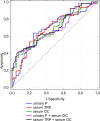The Clinical and Biochemical Predictors of Bone Mass in Preterm Infants
- PMID: 27806112
- PMCID: PMC5091911
- DOI: 10.1371/journal.pone.0165727
The Clinical and Biochemical Predictors of Bone Mass in Preterm Infants
Abstract
Background: Metabolic bone disease of prematurity still occurs in preterm infants, although a significant improvement in neonatal care has been observed in recent decades. Dual-energy X-ray absorptiometry (DXA) is the precise technique for assessing bone mineral content (BMC) in preterm infants, but is not widely available.
Aim: To investigate the clinical and biochemical parameters, including bone metabolism markers as potential predictors of BMC, in preterm infants up to 3 months corrected age (CA).
Materials and methods: Ca-P homeostasis, iPTH, 25-hydroxyvitamin D, osteocalcin, N-terminal propeptide, cross-linked C-telopeptide and amino-terminal pro C-type natriuretic peptide and the DXA scans were prospectively performed in 184 preterm infants (≤ 34 weeks' gestation) between term age and 3 mo CA. Lower bone mass was defined as BMC below or equal to respective median value for the whole study group, rounded to the nearest whole number.
Results: The appropriate quality DXA scans were available for 160 infants (87%) examined at term and for 130 (71%) tested at 3 mo CA. Higher iPTH level was the only independent predictor of lower BMC at term, whereas lower BMC at 3 mo CA was associated both with lower urinary phosphate excretion and higher serum osteocalcin level. ROC analysis showed that iPTH >43.6 pg/mL provided 40% sensitivity and 88% specificity in identification of preterm infants with lower BMC at term. In turn, urinary phosphate excretion (TRP>97% or UP/Cr ≤0.74 mg/mg) and serum osteocalcin >172 ng/mL provided 40% sensitivity and 93% specificity in identification of infants with decreased BMC at 3 mo CA.
Conclusion: Serum iPTH might to be a simple predictor of reduced BMC in preterm infants at term age, but urinary phosphate excretion and serum osteocalcin might predict reduced BMC at 3 mo CA. These results represent a promising diagnostic tool based on simple, widely available biochemical measurements for bone mass assessment in preterm infants.
Conflict of interest statement
The authors have declared that no competing interests exist.
Figures
References
MeSH terms
Substances
LinkOut - more resources
Full Text Sources
Other Literature Sources
Medical
Miscellaneous


